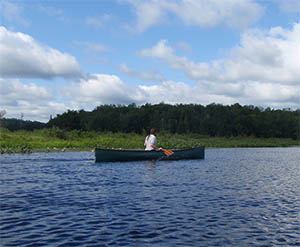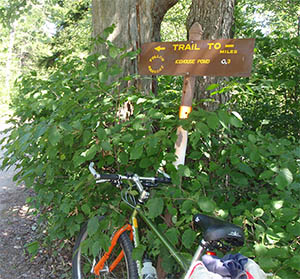
The State Land Master Plan - what it is, what it does, and why we're lucky to have it
Tuesday, October 28, 2014
By: Lisa M. Genier
The state-owned land in the Adirondack Park is called the Forest Preserve, and it is very special. It is protected from logging, lease or sale and development by Article XIV of the New York State Constitution, also known as the Forever Wild Clause.

But Forever Wild doesn’t mean forever locked up. On the contrary, the Forest Preserve is a place where a wide variety of human use and recreation can occur. In fact, 10-million people visit the Adirondacks every year, enjoying the benefits of the Park and Forest Preserve, and spending money that supports local businesses and communities.
Because the Forest Preserve contains most of New York’s most rare and sensitive forests, waters and wildlife, the state created the Adirondack Park State Land Master Plan (the Master Plan) to guide its management.
The Master Plan classifies the Forest Preserve into seven categories, based on the land’s characteristics and capacity to withstand use, and determines what uses are appropriate on these areas. Click HERE for a list of categories and more information.
You may be thinking to yourself, “What exactly does that mean?” Well, it means that certain areas of the Forest Preserve need more protection than others, like those that are home to rare, endangered or unique plants and animals.
For example, one of the main categories of land under the Master Plan is called “Wilderness.” In these areas, motorized access is not allowed because of the sensitivity of the natural resources on these lands. People can hike, kayak, sail, camp, canoe, fish, hunt, etc., but motor-vehicles and motorboats are prohibited. These lands - the greatest wilderness in the east - can provide an extremely rare opportunity for solitude, where a visitor can escape the sounds of civilization.
Another major category of state-owned land under the Master Plan is known as “Wild Forest.” While the name may seem similar to “Wilderness,” the management of these areas is very different. Higher-impact recreation is allowed in Wild Forest areas. That’s not to say that these resources don’t need protecting, but they can withstand more human use than Wilderness areas. People can use certain motorized vehicles on roads and motorboats on water bodies in these are as. Seaplanes are also allowed. The majority of the Forest Preserve land in the Adirondack Park is classified as Wild Forest.
as. Seaplanes are also allowed. The majority of the Forest Preserve land in the Adirondack Park is classified as Wild Forest.
One of the most beautiful aspects of the Master Plan is that it ensures that there are opportunities for everyone to enjoy the Forest Preserve. From a multi-week expedition in complete isolation in a Wilderness area, to a family day trip to a historic site, and everything in between…people of all ages and abilities can experience this treasure.
And even with all of the recreational opportunities that are provided to hikers, paddlers, hunters and anglers, cyclists, horseback riders, and skiers, the primary goal of the Master Plan is to protect the natural resources on the Forest Preserve. On the first page of the Plan there is a paragraph which states…
“If there is a unifying theme to the master plan, it is that the protection and the preservation of the natural resources of the state lands within the Park must be paramount. Human use and enjoyment of those lands should be permitted and encouraged, so long as the resources … are not degraded.”
The Master Plan is just one of the reasons why you and I are able to enjoy places in the Adirondack Park year after year. And why our children and grand-children will be able to enjoy clean water, wildlife, vibrant communities, and the same Wilderness lake that we do now. Or why we still have plants – and native strains of brook trout -- in the Adirondacks that can’t be found anywhere else on the planet.
Aren’t we lucky to have it?
Would you like to comment on what you've read or viewed? We'd love to hear from you. Please click to send us a message.
 Lisa M. Genier joined the Council in 1992 working as its Legislative Associate in the Albany office. During her tenure, she played a role in the creation of the Environmental Protection Fund, which has been used to fund land purchases and environmental programs in the Adirondack Park and around the state. She was also a member of the negotiating teams that worked on re-licensing agreements for several hydroelectric facilities in the Park, which preserved thousands of acres of land, expanded recreational opportunities, and protected other natural resources. Lisa now works part-time as Program Analyst writing action alerts, interacting with members, managing the Council’s website, and serving in a consultative role on legislative and other issues.
Lisa M. Genier joined the Council in 1992 working as its Legislative Associate in the Albany office. During her tenure, she played a role in the creation of the Environmental Protection Fund, which has been used to fund land purchases and environmental programs in the Adirondack Park and around the state. She was also a member of the negotiating teams that worked on re-licensing agreements for several hydroelectric facilities in the Park, which preserved thousands of acres of land, expanded recreational opportunities, and protected other natural resources. Lisa now works part-time as Program Analyst writing action alerts, interacting with members, managing the Council’s website, and serving in a consultative role on legislative and other issues.
Lisa is a member of the Department of Environmental Conservation’s Accessibility Advisory Committee that works to make the Forest Preserve and other DEC facilities around the state more accessible for people with disabilities while protecting the natural resources.
Lisa grew up in Mineville (Town of Moriah) in the Adirondacks. She attended the State University of New York at Oneonta and graduated in 1989 summa cum laude with degrees in Political Science and Business Economics. Lisa currently lives in Schenectady with her partner, Val and their four cats and dog.




